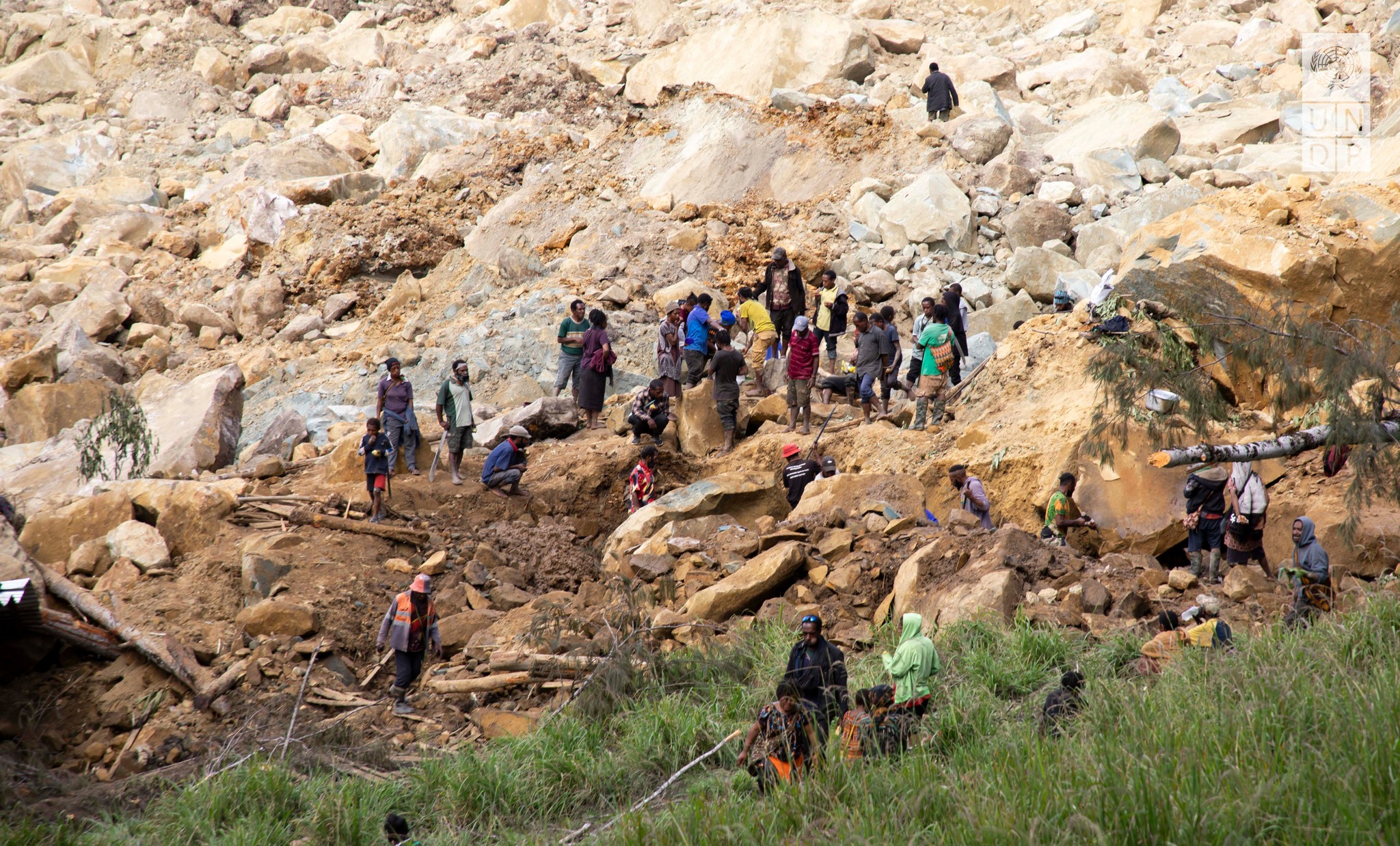A month after a deadly landslide buried more than a hundred people in Yambali, Papua New Guinea, bodies remain under rubble. The remote island’s “perfect storm” of underlying conditions makes recovery impossible, and a repeat all but guaranteed.
A deep resounding crack could have been the warning for residents in Papua New Guinea’s Yambali village to escape or to seek shelter in the early hours of May 24, but in the absence of guidance from local officials, few listened. Hours later, when day broke, survivors of the landslide that destroyed 35 acres stood helpless, witness to more than a hundred buildings and countless people buried under rocks.
Information was lean and often contradictory in the days to come. Death tolls, access to aid and information remain in flux. Meanwhile, scientists are still unsure what exactly caused the earth to shift in the country’s Enga province.
“The earth is still moving, the situation is still moving, based on initial geotechnical accountings made public,” Factal’s Oceania Editor Matthew Hipolito said. “A more academic accounting will probably not be released publicly for a while as assessments are still ongoing.“
A seismic landslide was unofficially ruled out early on. However, the combination of Papua New Guinea’s location, climate and topography make it susceptible to more than one type of landslide trigger. Papua New Guinea is one of the wettest climates in the world with annual rainfall in excess of 2,500 millimeters.
“When you combine the sort of precipitation Enga province receives — about 252 millimeters per month — with the mountainous terrain of the islands, it’s not a good combination because it can make the soil unstable,” Hipolito said.
Geotechnical engineers from New Zealand who visited Yambali in the aftermath found the ground in and around the 35-acre landslide so unstable that it would be “impossible to stop it from moving” and that it could keep doing so for years. The team estimated this avalanche was a reactivation of an old landslide by recent rainfall.
On June 17, officials ended the effort to recover the more than 150 people estimated buried alive after revising down the initial toll from 2,000.
“The earth is still moving, the situation is still moving”
Yambali, now evacuated with past signs of life sealed under massive rocks, has turned into an unstable burial site where decaying remains and uncontained sewage could be contaminating groundwater supplies.
“It is now a quarantine zone … not only because the land is still moving and dangerous but also because of the risk of disease from decaying bodies under the rubble,” Hipolito said.
There is scant information about the scale of the restricted zone due to the limited framework of media and information dissemination in Papua New Guinea.
Unwilling to leave their loved ones now buried under the immovable rubble, many of the Yambali survivors set up makeshift shelters dangerously close to the landslide site.
The New Zealand geotechnical team advised the immediate relocation of the population of so-called red zones, including Yambali, an area the UN estimates includes some 7,400 people. The government said it is in the process of acquiring land, but it reportedly lacks even the most basic infrastructure of now, throwing into question the timeline of permanent resettlement.
The relocation of thousands of people across terrain as tricky as Papua New Guinea’s highlands is further complicated by tribal tensions.
“It is very much a perfect storm, relating to development conditions and the terrain itself”
Enga is home to long-standing conflicts involving more than a dozen tribes. These quickly turn deadly with the aid of semi-automatic weapons and a weak legal system. To reach Yambali in the days immediately after the May 24 landslide, aid convoys traversed areas rife with tribal fighting that left at least 12 people dead.
“The resettlement process could take the balance of this year because of the complication of tribal clashes,” Hipolito said.
The displacement and subsequent rush to normalization have also threatened the rites and rituals that define communities, a potential fuel for further conflict. Less than a month after the avalanche, a bypass road was constructed through what is now a sacred burial site, leaving tribespeople feeling unheard by authorities.
The Yambali landslide highlighted a failure in Papua New Guinea to prepare for natural disasters, despite such calamities impacting hundreds of thousands of its people over the last several decades on the island.
“It is very much a perfect storm, relating to development conditions and the terrain itself,” Hipolito said. “How could we have lowered the human toll? It’s not like you can predict these disasters — mitigation is universally a thing of development and they don’t have the resources to prepare for something like this.”
Written by Halima Mansoor. Edited by Jillian Stampher.
Further reading:
- Review Factal’s coverage of the landslide in Yambali, Papua New Guinea, on our topic page (members link)
- Read this ABC.net photo essay with first-hand accounts from June 4
- This piece by the Guardian explores tribal conflict in Enga province of Papua New Guinea
Thanks for reading! If you enjoyed this edition, sign up here to receive The Debrief in your inbox on the first of every month.
Top photo: Locals searched the rubble for possible survivors after the landslide in Yambali, Papua New Guinea, caused roads and a bridge to collapse, initially delaying help from authorities as seen in this image from May 28. (UNDP in Papua New Guinea)
Factal gives companies the facts they need in real time to protect people, avoid disruptions and drive automation when the unexpected happens.
Try Factal for free or talk with our sales team (sales@factal.com) for a demo.

